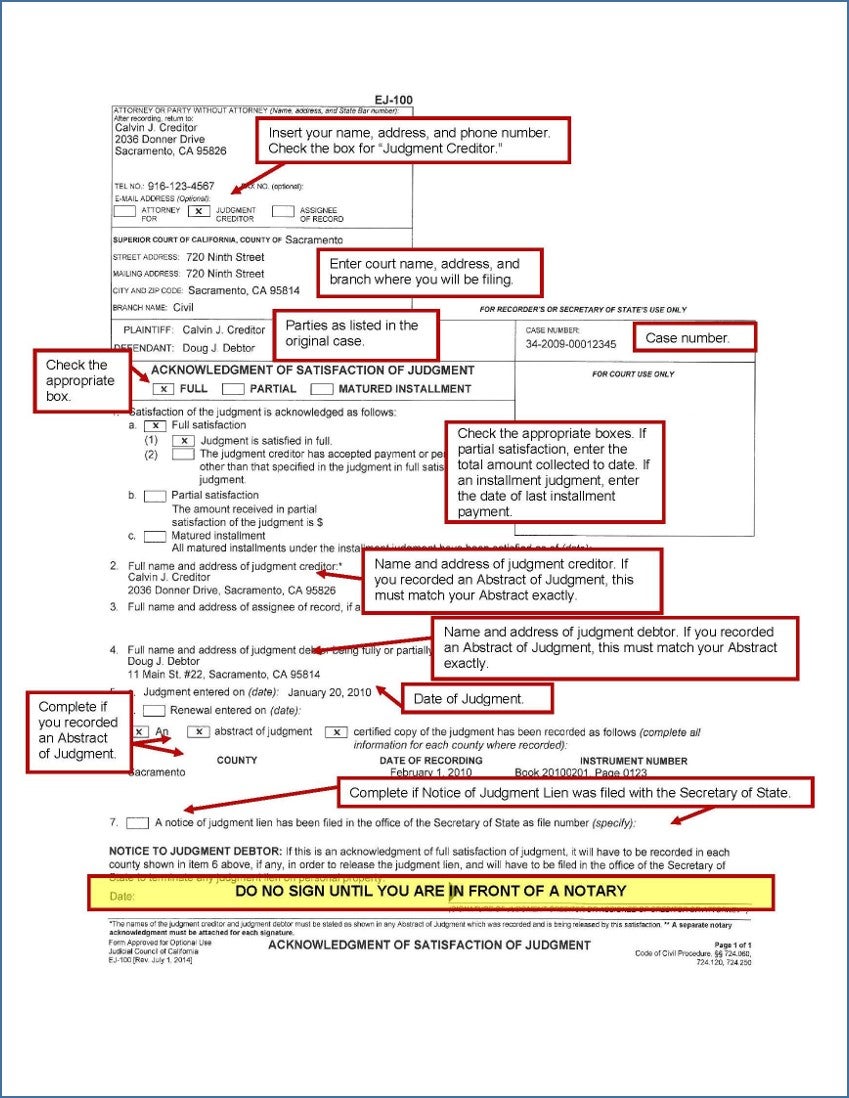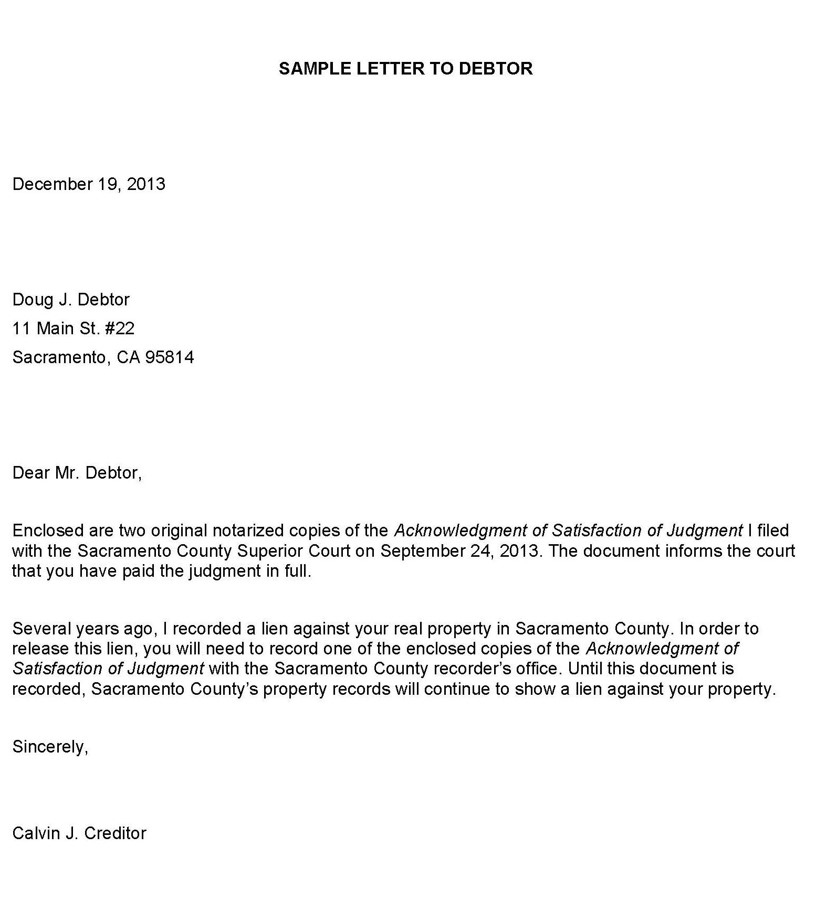Satisfaction of Judgment
Once a judgment is paid, either in full or in an amount the judgment creditor agrees to accept as full payment, the judgment creditor must immediately file an Acknowledgement of Satisfaction of Judgment (EJ-100) with the court (California Code of Civil Procedure (CCP) § 724.030). This form serves as a receipt for full payment of the judgment, and formally closes the case with the court.
Templates and Forms
A judgment debtor is also entitled to an acknowledgement of partial satisfaction of a judgment (CCP § 724.110). This gives the debtor proof of how much has been paid toward a judgment. For more information about partial satisfactions of judgment, see Matthew Bender Practice Guide: California Debt Collection and Enforcement of Judgments, KFC 1065 .E5 M38, Chap. 24.
If the judgment creditor does not immediately file an Acknowledgement of Satisfaction of Judgment (EJ-100) when the judgment is satisfied, the judgment debtor may make a formal written demand for the creditor to do so. The judgment creditor has 15 days after receiving the debtor’s request to serve the acknowledgement.
If the acknowledgment is not served within 15 days, the judgment debtor may sue the judgment creditor for any damages caused by the failure to acknowledge payment. Damages can include the failure to obtain a loan or employment as the result of an inaccurate credit report; any attorney’s fees related to the suit to acknowledge payment; and a statutory award of $100 (CCP § 724.050).
If the judgment was satisfied by writ of execution (e.g., a wage garnishment), the court clerk will enter a satisfaction of judgment when the levying officer returns the writ as satisfied for the full amount of the judgment (CCP § 724.030). In this situation, the creditor does not need to file anything unless they have also recorded an abstract of judgment to place a lien on the judgment debtor’s property. If they recorded an abstract of judgment, the creditor will still need to file an Acknowledgement of Satisfaction of Judgment (EJ-100).
Step-by-Step Instructions
1
Complete the Form
Instructions for completing an Acknowledgment of Satisfaction of Judgment (EJ-100) are available at the end of this Guide. This form must be notarized (CCP § 724.060), so do not sign it until you are in front of a notary public.
2
Make Copies
Make photocopies of your unsigned Acknowledgment of Satisfaction of Judgment (EJ-100). You will need to obtain several original, notarized copies of this form. The total number you will need depends on your collection efforts.
You will need one original, notarized copy for the judgment debtor.
If you recorded an abstract of judgment to place a lien against the debtor’s real property, you will need an original, notarized copy of your Acknowledgment of Satisfaction of Judgment (EJ-100) for each county where you placed a lien.
If you were a secured creditor and filed a Notice of Judgment Lien (Form JL1) against personal property through the Secretary of State’s office, you will need an original, notarized copy of your Acknowledgment of Satisfaction of Judgment (EJ-100) to release the lien.
3
Notarize Your Forms
Sign all copies of the Acknowledgment of Satisfaction of Judgment (EJ-100) in the presence of a notary public. The notary will attach their acknowledgement page to your form. Make two photocopies of the notarized Acknowledgment of Satisfaction of Judgment (EJ-100), including the acknowledgement page. You can photocopy any of your notarized copies, as they should all be the same. One copy is for your records; the other will be filed with the court.
ABOUT NOTARIES…
A Notary Public verifies only the identity of the individual who signed the document, not the truthfulness, accuracy, or validity of that document. Be sure to bring a valid ID with you, such as a driver’s license or passport. The Notary will verify your identity, witness your signature, and then affix his or her seal to the document. You can find a notary at your bank, a mailing service, or in the Yellow Pages.
The original signed and notarized document must be served on the debtor, who must use it to clear liens.
4
Have your Acknowledgement Served
You must have the Acknowledgment of Satisfaction of Judgment (EJ-100) served on the judgment debtor by someone over 18 who is not a party to the case. Be sure the judgment debtor receives all the original, notarized copies he or she will need to release all of the liens you placed on his or her property.
Many creditors find it helpful to include a cover letter, explaining to the judgment debtor that he or she is responsible for removing liens from their own property, and providing a list of all the liens you placed during the collection process. A sample letter is included at the end of this Guide.
Service may be made in person or by mail. The server (not you!) must complete a proof of service form, either a Proof of Personal Service (POS-020) or a Proof of Service by First Class Mail (POS-030). For more information on these Proofs of Service, see the Guides on our website.
Make two photocopies of the signed proof of service.
5
File the Acknowledgement in Court
File two photocopies of the Acknowledgment of Satisfaction of Judgment (EJ-100) and signed Proof of Service in the drop box in Room 102 at the Gordon D. Schaber Courthouse at 720 Ninth Street, along with a self-addressed, stamped envelope so that the court may return a copy stamped “Endorsed/Filed” to you.
For Help
SH@LL (Self-Help at the Law Library)
609 9th Street, Sacramento CA 95814
(916) 476-2731 (Appointment Request Line)
Services Provided: SH@LL provides general information and basic assistance to self-represented litigants on a variety of legal issues. All assistance is provided by telephone. Visit “What we can help with” for a list of qualifying cases.
Eligibility: Must be a Sacramento County resident or have a qualifying case in the Sacramento County Superior Court.
For More Information
California Practice Guide: Enforcing Judgments and Debts KFC 1065 .A9 S3
Debt Collection Practice in California KFC 256 .C83
Electronic Access: On the Law Library’s computers, using OnLaw.
How to Collect When You Win a Lawsuit in California KFC 1065 .Z9 H69 (Reference)
Matthew Bender Practice Guide: California Debt Collection and Enforcement of Judgments KFC 1065 .E5 M38
Electronic Access: On the Law Library’s computers, using Lexis Advance.
Samples
Acknowledgement of Satisfaction of Judgment

Letter to Debtor

This material is intended as general information only. Your case may have factors requiring different procedures or forms. The information and instructions are provided for use in the Sacramento County Superior Court. Please keep in mind that each court may have different requirements. If you need further assistance consult a lawyer.




